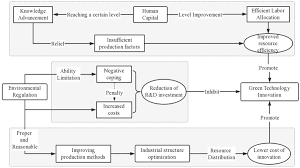
In this paper, the provincial panel data of china from the year 2006 to 2019 are used to analyze the association among environmental regulations, industrial structure od industries and low-carbon development. The results show that regional industrial CO2 emissions in China's east, center, and west were greatly decreased by environmental restrictions. The most significant deterrent to carbon emissions in the central region was, notably, environmental regulatory measures. By encouraging improvements in industrial structure and increasing its efficiency, the study shows that these rules helped to lower industrial carbon emissions. The examination of the sub-sample mechanism reveals significant regional variations: an advanced industrial structure was a major force behind low-carbon development in the western region, whereas high-efficiency industrial structures were critical in the eastern region. Through structural changes in the business, environmental restrictions can effectively promote low-carbon economic growth, as this study highlights. Across a range of control factors, environmental regulation considerably decreased regional industrial carbon emissions by about 0.196 to 0.033. Trade openness, urbanization, and the development of human capital all helped to reduce carbon emissions by roughly 1.057 to 4.104. The efficacy of regulatory tools was verified by endogeneity tests, which yielded coefficients varying between -0.891 and -0.156 for distinct factors. The results offering actual proof of the varying effects of environmental laws in various geographical areas and highlight the necessity of specialized policy strategies to promote sustainable development.
Total file downloads: 40